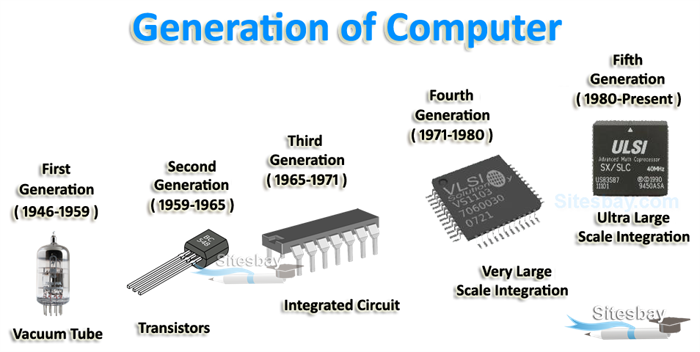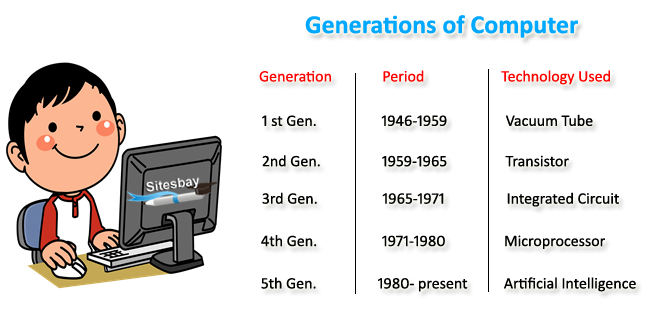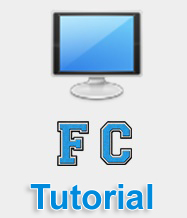Genration of Computer
Genration of Computer
Generation in computer terminology is a change in technology a computer is/was being used. Initially, the generation term was used to distinguish between varying hardware technologies.

As the time passed, the device of more suitable and reliable machine was need which could perform our work more quickly. During this time, in the year 1946, the first successful electronic computer called ENIAC was developed and it was the starting point of the current generation of computer
| Generations of computers | Generations timeline | Evolving hardware |
|---|---|---|
| First generation | 1946-1959 | Vacuum tube based |
| Second generation | 1959-1965 | Transistor based |
| Third generation | 1965-1971 | Integrated circuit based |
| Fourth generation | 1971-1980 | Microprocessor based |
| Fifth generation | 1980-present | Artificial intelligence based |

FIRST GENRATION
The period of first generation : 1942-1954. Vaccum tube based.
ENIAC was the world first successful electronic computer which was develops by the two scientists namely J. P. Eckert and J. W. Mauchy. It was the beginning of first generation computer. The full form of ENIAC is 'Electronic Numeric Integrated And Calculator' ENIAC was a very huge and big computer and its weight was 30 tones. It could store only limited or small amount of information. Initially in the first generation computer the concept of vacuum tubes was used. A vacuum tube was such an electronic component which had very less work efficiency and so it could not work properly and it required a large cooling system.
Characteristics of First Generation of Computers (1940s-1950s)
- Main electronic component: vacuum tube
- Main memory: magnetic drums and magnetic tapes
- Programming language: machine language
- Power: consume a lot of electricity and generate a lot of heat.
- Speed and size: very slow and very large in size (often taking up entire room).
- Input/output devices: punched cards and paper tape.
- Examples: ENIAC, UNIVAC1, IBM 650, IBM 701, etc.
- Quantity: there were about 100 different vacuum tube computers produced between 1942 and1963.
SECOND GENERATION
The period of second generation : 1952-1964. Transistor based.
As the development moved further, the second generation computers knocked the door. In this generation, transistors were used as the electronic component instead of vaccum tubes .A transistors is much smaller in the size than that of a vaccum tube. As the size of electrons components decreased from vaccum tube of transistor, the size of computer also decreased and it became much smaller than that of earlier computer.
Characteristics of Second Generation of Computers (1950s-1960s)
- Main electronic component: transistor
- Memory: magnetic core and magnetic tape / disk
- Programming language: assembly language
- Power and size: low power consumption, generated less heat, and smaller in size (in comparison with the first generation computers).
- Speed: improvement of speed and reliability (in comparison with the first generation computers).
- Input/output devices: punched cards and magnetic tape.
- Examples: IBM 1401, IBM 7090 and 7094, UNIVAC 1107, etc.
THIRD GENERATION
The period of third generation : 1964-1972. Integrated Circuit based.
The third generation computers were invented in the year 1964. In this generation of computer, IC (Integrated circuits) was used as the electronic component for computers. The development of IC gave birth to a new field of microelectronics. The main advantage of IC is not only its small size but its superior performance and reliability than the previous circuits. It was first developed by T.S Kilby. This generation of computer has huge storage capacity and higher calculating speed.
Characteristics of Third Generation of Computers (1960s-1970s)
- Main electronic component: integrated circuits (ICs)
- Memory: large magnetic core, magnetic tape / disk
- Programming language: high level language (FORTRAN, BASIC, Pascal, COBOL, C, etc.)
- Size: smaller, cheaper, and more efficient than second generation computers (they were called minicomputers).
- Speed: improvement of speed and reliability (in comparison with the second generation computers).
- Input / output devices: magnetic tape, keyboard, monitor, printer, etc.
- Examples: IBM 360, IBM 370, PDP-11, UNIVAC 1108, etc.
FOURTH GENERATION
The period of fourth generation : 1972-1990. VLSI microprocessor based.
This is the generation where we are working today. The computers which we see around us belong to the fourth generation computers. 'Micro processor' is the main concept behind this generation of computer.
A microprocessor is a single chip (L.S.I circuit), which is used in a computer for any arithmetical or logical functions to be performed in any program. The honaur of developing microprocessor goes to Ted Hoff of U.S.A. He developed first micro-processor, the Intel 4004, as he was working for Intel Corporation, U.S.A with the use of microprocessor in the fourth generation computers, the size of computer become very fast and efficient.
It is evident that the next generation of computer i.e. fifth generation will be developed soon. In that generation, computer will possess artificial intelligence and it would be able to take self decisions like a human being.
Characteristics of Fourth Generation of Computers (1970s-present)
- Main electronic component: very large-scale integration (VLSI) and microprocessor.
- VLSI: thousands of transistors on a single microchip.
- Memory: semiconductor memory (such as RAM, ROM, etc.)
- RAM (random-access memory): A type of data storage (memory element) used in computers that temporary stores of programs and data (volatile: its contents are lost when the computer is turned off).
- ROM (read-only memory): A type of data storage used in computers that permanently stores data and programs (non-volatile: its contents are retained even when the computer is turned off).
- Programming language: high level language (Python, C#, Java, JavaScript, Rust, Kotlin, etc.). A mix of both third- and fourth-generation languages
- Size: smaller, cheaper and more efficient than third generation computers.>
- Speed: improvement of speed, accuracy, and reliability (in comparison with the third generation computers).
- Input / output devices: keyboard, pointing devices, optical scanning, monitor, printer, etc.
- Network: a group of two or more computer systems linked together.
- Examples: IBM PC, STAR 1000, APPLE II, Apple Macintosh, etc.
Fifth Generations of Computers
The period of fifth generation : 1990-onwards.ULSI microprocessor based.
Fifth generation computing devices, based on artificial intelligence, are still in development, though there are some applications, such as voice recognition, that are being used today. The use of parallel processing and superconductors is helping to make artificial intelligence a reality. Quantum computation and molecular and nanotechnology will radically change the face of computers in years to come. The goal of fifth-generation computing is to develop devices that respond to natural language input and are capable of learning and self-organization.
Characteristics of Fifth Generation of Computers (the present and the future)
- Main electronic component: based on artificial intelligence, uses the Ultra Large-Scale Integration (ULSI) technology and parallel processing method.
- ULSI: millions of transistors on a single microchip
- Parallel processing method: use two or more microprocessors to run tasks simultaneously.
- Language: understand natural language (human language).
- Power: consume less power and generate less heat.
- Speed: remarkable improvement of speed, accuracy and reliability (in comparison with the fourth generation computers).
- Size: portable and small in size, and have a huge storage capacity.
- Input / output device: keyboard, monitor, mouse, trackpad (or touchpad), touchscreen, pen, speech input (recognise voice / speech), light scanner, printer, etc.
- Example: desktops, laptops, tablets, smartphones, etc.

